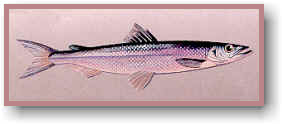
Rainbow/American Smelt
Osmerus mordax
Status
Native to Newfoundland and Labrador.
Habitat
Smelt are a schooling fish, inhabiting mid-waters of lakes or inshore coastal waters. They are sensitive to both temperature and light. In Newfoundland the smelt exists in two forms: anadromous (spend their life in both fresh and salt water) and landlocked.
Range
Atlantic drainages from Lake Melville in Labrador to Pennsylvania in the U.S., west through to the Great Lakes.
Food
Shrimp-like crustaceans, amphipods, aquatic insect larvae and aquatic worms. Landlocked smelt may eat both young trout and trout eggs. Also, because of their high numbers, they may have a significant impact on a system’s aquatic ecology.
Appearance
Olive above, blue or pink iridescence on silver sides; usually with a silver stripe along the sides.
Breeding Biology
In spring, the sexually mature and ripe smelt will leave the sea or large lakes and travel upstream to spawn. In Newfoundland this may occur when ice is still on many of the lakes, but usually occurs in March, April or May, depending on latitude and temperature, but 8.9oC is optimal. The precise time of spawning is quite specific to the individual stream. Spawning may last up to three weeks, but the peak seldom lasts more than a week.
Spawning takes place at night, with spawners returning to the lake or ocean by day. Both sexes become shorter in length as the spawning period progresses. Two males will align themselves on either side of a ripe female. The female releases her eggs in clusters, with the milk of both males being released simultaneously. Eggs become adhesive shortly after extrusion, and attach to bottom gravel.
